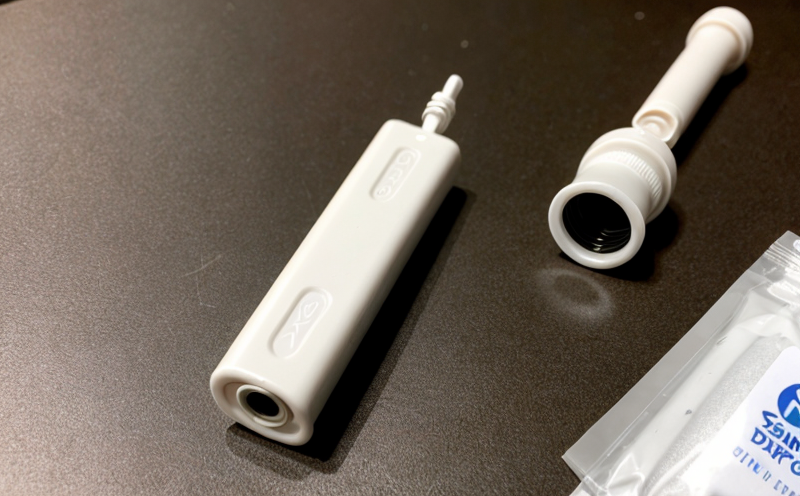ISO 10993-17 Leachables Risk Assessment for Single-Use Devices
The ISO 10993 series of standards provides a comprehensive framework to ensure that medical devices are safe and effective. Among these, ISO 10993-17, specifically focuses on the determination of leachable substances from single-use medical devices (SUDs). This service is critical for ensuring that any materials or additives used in SUDs do not pose a risk to patient safety.
The process begins with a comprehensive evaluation of all potential leachables. Leachables are defined as chemicals, metals, or other substances released from the device during its intended use. These substances can include materials from the manufacturing process, such as lubricants or coatings, and can potentially affect patients’ health if not properly controlled.
The primary goal of this service is to identify leachable substances that could interact with biological systems. The testing protocol involves several steps:
- Identification and characterization of the device’s materials,
- Determining potential release scenarios,
- Assessment of the risks associated with these releases.
The service aims to provide a detailed risk assessment report that helps our clients understand the implications of leachable substances in their devices. This information is crucial for regulatory compliance and ensuring patient safety.
| Applied Standards |
|---|
| ISO 10993-17:2016 |
| ASTM F2584 |
| EN ISO 10993-17 |
The testing protocol follows the guidelines provided by these standards. The process involves the following key steps:
- Material Identification: Detailed analysis of all materials used in the device, including additives and coatings.
- Release Scenarios: Simulation of real-world use conditions to predict potential leachables.
- Risk Assessment: Evaluation of identified substances based on their potential risks to human health.
The service also includes a review of the latest regulatory requirements and best practices in the industry. This ensures that our clients are always working towards compliance with current standards and expectations.
In summary, this service provides an in-depth analysis of leachable substances from single-use medical devices. The aim is to ensure that any potential risks are identified early in the product development process, thereby minimizing the need for expensive redesigns later on. This proactive approach not only enhances patient safety but also streamlines regulatory approvals.
Applied Standards
| Applied Standards |
|---|
| ISO 10993-17:2016 |
| ASTM F2584 |
| EN ISO 10993-17 |
The primary standard for this service is ISO 10993-17:2016. This international standard provides a framework for the determination of leachable substances from single-use medical devices. It outlines the steps necessary to identify, characterize, and evaluate potential risks associated with these materials.
The ASTM F2584 standard complements ISO 10993-17 by offering additional guidance on testing methodologies and acceptance criteria for SUDs. This ensures that our clients have a robust set of standards to follow when conducting leachables assessments.
European harmonization is also important, as indicated by the EN ISO 10993-17 standard. This allows manufacturers to meet EU regulatory requirements while ensuring consistency with international best practices.
Industry Applications
The ISO 10993-17 leachables risk assessment is applicable across various sectors within the medical device industry, including:
- Bioprocessing equipment,
- Dialysis machines,
- Infusion pumps,
- Surgical instruments.
This service is particularly relevant for manufacturers of single-use devices that come into contact with biological fluids or tissues. By ensuring the safety of these materials, we help our clients meet stringent regulatory requirements and enhance patient outcomes.
The application of this standard extends beyond just compliance; it also supports innovation by allowing developers to identify potential risks early in the design phase. This proactive approach can lead to safer devices with fewer recalls and better overall performance.
Use Cases and Application Examples
To illustrate the practical application of this service, consider a case study involving a manufacturer of single-use dialysis machines. In this scenario:
- Step 1: Material Identification: The first step was to identify all materials used in the device, including the polyvinyl chloride (PVC) membrane and various lubricants.
- Step 2: Release Scenarios: Potential release scenarios were simulated under conditions similar to those encountered during dialysis. This included testing at different temperatures and exposure times.
- Step 3: Risk Assessment: The identified leachables were then evaluated based on their potential risks to patients. For example, certain metals found in the PVC membrane could pose a risk if they migrated into the patient's blood stream.
The result was a detailed report that highlighted areas of concern and recommended mitigation strategies. This information was invaluable for the manufacturer as they revised their product design to eliminate risks identified during testing.
This example demonstrates how ISO 10993-17 can be used effectively in real-world applications. By following this protocol, manufacturers can ensure that their single-use devices meet the highest standards of safety and quality.





